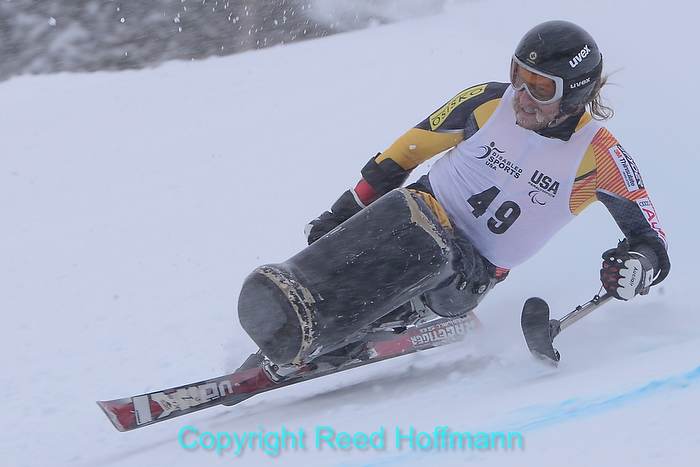This December was the fourth in a row I’ve spent a week at a ski resort in Colorado, doing very little skiing. Instead I’m shooting pictures and video. That’s because I’m there to help Disabled Sports USA document their Ski Spectacular, a week of teaching disabled people to ski. And it’s become one of the most rewarding times of the year for me.
A few years back I was part of a pro photographer program Microsoft sponsored, and they offered us grant money to pursue a project. I wanted to find something that involved people and the outdoors, and heard about Disabled Sports USA. I contacted them and then started attending some of their events to build a library of photos to promote their activities. As an old newspaper photographer, I saw great stories, and stated creating
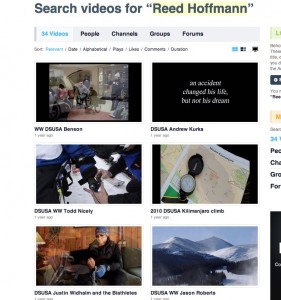
Most of the multimedia stories I’ve created are posted on my channel at Vimeo. Click this image to see some of them.
multimedia pieces (stills with audio) to tell those stories. In time that led to shooting video for those stories, and now that’s primarily what I do. Each event has been a learning experience, and this one was no different. You can see some of the past stories I’ve done by clicking on the screenshot of my Vimeo channel on the left.
There are two parts to what I do in Colorado. The first is the learn-to-ski event (Ski Spectacular) at Beaver Run Resort in Breckenridge, the second a NORAM race that DSUSA runs at nearby Copper Mountain the following week. This year they wanted me to focus on two young Marines who had lost limbs to IED blasts in Afghanistan, and are now competing for spots on the U.S. Paralympic team. First I’d be shooting video of them training and conduct interviews at Breckenridge, then follow them to Copper and shoot more, plus stills of all the athletes competing in the races.
When I started shooting video I quickly realized it was more complicated than the stills I was used to. First, audio is critical. Bad
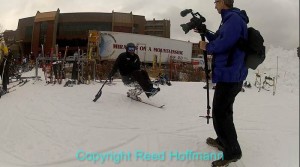
In this screengrab from a GoPro, you can see the Manfrotto fluid head monopod I came to love.
audio can kill good video, and good audio can make mediocre video look good. Second, shaky video tends to be bad, uncomfortable to watch. Third, I’d be shooting my video with still cameras, and while DSLR’s offer some great advantages (shallow depth of field, good performance in poor light), they don’t autofocus well with action. And finally, video has to tell a story, where stills can stand alone. So when preparing to shoot video, I have to think about my gear differently and have a plan for the story I’m telling.
I took three Nikon cameras: the D600, D800 and V1 (which all use the same battery, a key factor). The D600 would be my workhorse, not only giving me great videos indoors and out, but having a fast enough frame rate to shoot stills during the races. The D800 would
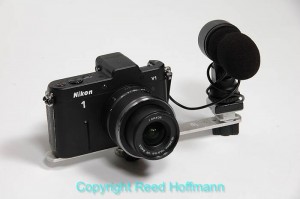
The Nikon V1, with its new hybid autofocus system, became my go-to camera for shooting video of the participants skiing towards me. I used an old flash bracket to add one of my external mics.
be my back-up (only very lucky photographers go to big events with just one camera). And most people would be surprised at the addition of the Nikon V1, considering I have much larger and higher-resolution cameras available. But the V1 would play a very important role for me. Not only can it shoot video at the same quality as the other cameras, but it also has an electronic viewfinder, letting me use the camera at my eye more easily than the other cameras with the bulky magnified hood attached. But most importantly, it uses a new hybrid autofocus system (combining Contrast and Phase detection) to give it excellent tracking capability for action coming at me. Which would be critical when shooting skiing. Plus, the V1 offers an electronic shutter option, which would let me shoot some scenes as high-resolution stop-action sequences, which I’d then turn into video.
For lenses the Nikkor 24-120mm f/4 VR was my main one on the
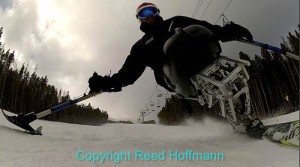
Putting a GoPro on the snow let me get shots like this without risking my expensive gear!
DSLR (with the 16-35mm f/4 VR for indoor wide shots), and the 30-110mm lens was the primary lens for shooting action with the V1. I also brought an 85mm 1.8 that I used for the interviews. And the racing was shot with the excellent Nikkor 70-300mm f/4.5-5.6 VR lens, one of my favorite budget lenses. Oh, and I added a pair of GoPros to the kit too. I wanted to mount cameras to the guys, plus set cameras in the snow for them to ski by (or over, as the case turned out!).
All of the cameras were set to 720p, 60fps, as I wanted the higher frame rate because of the action I’d be shooting. That faster frame rate (60 frames per second in this case, instead of the usual 30) means a higher shutter speed, so action looks sharper and you
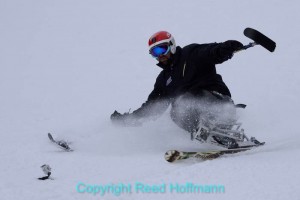
Josh about to ski over the GoPro to get the video that resulted in the frame above.
can make better slow-motion sequences.
With video, though, cameras are just part of the gear. To get good sound, I’d brought along two accessory microphones, a Sennheiser shotgun (MKE 400) and a Nikon wide-area (ME-1). I also had a pair of wireless mics, which would allow me to put a microphone on the guys and record sound without being attached. And as always, I had my compact Olympus digital recorder, for both the interviews and for collecting ambient sound.
For stability I took along a tripod (for the interviews) and a monopod. This monopod isn’t a normal monopod, though. It’s a unique design by Manfrotto that combines a panning device at the base (where it has three small feet) with a fluid head at the top. I
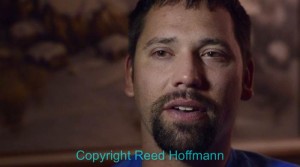
Josh during the interview, being shot with the D600 and 85mm 1.8 lens, using the small LED light panel for illumination.
first used one at the Lake Tahoe workshop (Pop Photo’s Mentor Series) and fell in love with it, so bought one for this trip.
With video, flash is no help, so I also packed a small LED light panel that I could use on a stand for the interviews.
Since I was going to have to ski with at least some of the gear, I took along two different bags to do that. A Thinktank waist bag (Chameleon) for the lighter outings, and a Lowepro sling bag (SlingShot 200 AW) for the bigger ones. Much as I prefer a waist bag, the sling bag was great for both access and shifting it to my front when getting on the lifts.
I pride myself on being able to do most photo trips with just one
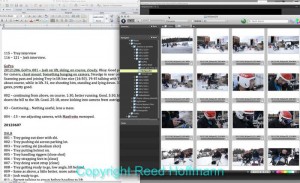
The most tedious part of the process is logging the audio and video. Here I’m using Photo Mechanic to preview the videos, and updating a Word doc with the info as I go.
checked bag. With a video project like this, though, two becomes my minimum. Ugh. I hate dragging lots of bags around. I was able to carry all the key cameras, lenses, sound gear, laptop and spare hard drives onto the planes with me in a Thinktank Airport backpack and Urban Disguise 50 shoulder bag.
The shoots went well. As with stills, exposure and white balance are critical. But now you have to think in movements – is the subject going to move, and if so, will you follow. If following, how will you do that smoothly? You have to think about your story, and how different parts of it will connect. “Continuity” is a big deal in video, and simply means do the shots fit together well and comfortably. Does the action, and the “feel” of the video flow? Every day was a mix of sun, clouds and snow. Figuring out how to transition between those was challenging.
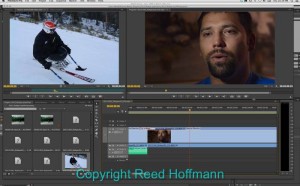
Once everything’s logged, I can start producing the video, using Adobe’s Premiere Pro CS6 on a MacBook.
You have to constantly be aware of the sound around you, and how you’re recording it. Wind is bad, can overwhelm your mic and your audio track. Being able to listen to the sound through the headphone jack was nice, but the audio meters on the LCD with the D600 and D800 were life-saving. They made it easy for me to be confident I was recording at the proper level.
Despite doing it a lot by now, I still hate shooting from skis – cold, windy, occasionally snowing, wearing gloves, limited mobility, trying to stand still on slippery slopes – not a recipe for easy video! The Manfrotto monopod helped me stay steady without the hassle of using a tripod. But it’s too big and bulky to ski with (at least for me).
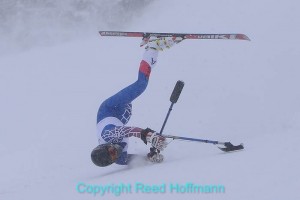
I’ll never be a really good skier because I’m afraid of falling. Racers are always pushing the edge, and these guys were no different, even skiing on one leg.
Oh, and there’s the little issue of staying warm. The biggest challenge there is on the race days. I need to ski the course once to look for spots to shoot, then ski a second time to get in position. And then wait. The first day I was in that one spot for three hours for the morning races. At which point my fingers and feet were numb. And yes, I’m using toe and hand warmers. But to shoot the camera you need thin gloves. And ski boots aren’t designed for standing still for long periods. Oh, and it was five-degrees out, with 10-12 mph wind. Brrrrr. I didn’t make it back for the afternoon session ☺. But I did stay out for both sessions the second day, since it was a toasty 15-degrees by then, with less wind.
When it’s all over, I build out photo galleries for the races, and allow the athletes to download the high-resolution images and use them however they like, for no charge. I send DSUSA a large
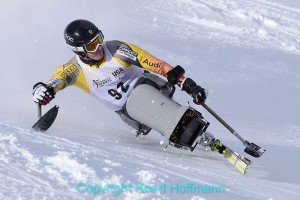
The hard part’s the video. When it gets to race days, I can relax and shoot stills, and marvel at how good these athletes are. Nikon D600, Nikkor 70-300mm f/4.5-5.6 lens, ISO 400, 1/2000 second at f/7.1.
collection of stills, and try to create short and long versions of the video(s), which they then use in different ways (including on their YouTube channel).
My image workflow starts, as usual with Photo Mechanic (Camerabits.com). The fastest, most powerful browser on the market, it also lets me preview video files, so I can quickly log the clips. The videos themselves are produced with Adobe’s Premiere Pro (now CS6). At the high end, you’ll either use Adobe Premiere or Apple Final Cut, and since I work on both Mac and Windows computers, Adobe was the only real choice. And I still like to edit my audio with Audacity, a nice, fairly simple, free editor. Still images I can turn around immediately, but the video and audio usually means about a week of work after I’m done shooting. With luck I’ll have this one done in the next few days.
The whole event is a lot of work, and very challenging at times. But it’s also the most inspirational thing I’ve ever been involved in. When you see what some of these people have been through, and how they’ve responded, it put your own life and problems in perspective. So as long as they want me back, I’ll be there.

